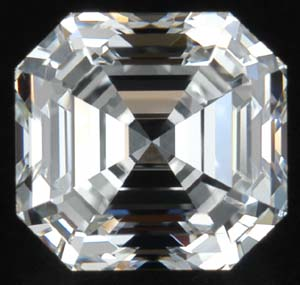The " Asscher cut diamond" is a stepped square cut, often called the "square emerald cut" and like an emerald cut, the Asscher has cropped corners in order to strengthen the diamond.
Named after its creator Joseph Asscher, owner of the Amsterdam-based diamond company of the same name, the Asscher cut was developed in the early 20th century at the birth of the stylish and popular Art Deco movement. Joseph Asscher rose to fame several years later when he was commissioned by King Edward VII to cut the famous 3,106-carat Cullinan diamond for the English crown jewels. In 1980 Her Majesty Queen Juliana of Holland granted the Asscher Diamond Company a royal title in recognition of the role the Asscher family and company had held in the diamond industry. This cut’s popularity peaked in the late 1920s but remained a somewhat rare commodity for the remainder of the century, available only in antique shops and specialised Art Deco jewellers. At the onset of the new millennium, following considerable research and development, the Asscher cut was redesigned with new specifications and additional facets for a more brilliant shine, and has since regained its popularity.
Asschers typically have the following characteristics:
- High crown
- Small table
- Deep and slightly bulging pavilion
- Wide cut corners
- Wide windmill reflection
- House of mirrors (concentric square patterns)
The Royal Asscher Cut has a high crown and 74 facets – whereas the modern square-emerald cut, and the original Asscher both have 58 facets. Today the Asscher family name is often used as a commodity term for square-emerald cuts. It is obvious why companies want to use the world-renowned Asscher name.
Very Square Asscher cuts (Ratio of 1:1) are preferred to even slightly more rectangular looking ones. Asscher cuts should not exceed a ratio of 1.1:1.
To fully appreciate the Asscher design, it is advisable to select a diamond of higher clarity (VS2 and above for GIA and VS1 and above for EGL, to ensure it is completely eye clean).
A table and depth percentage between 60 – 73.5% and 51 - 77% respectively is also recommended.
A table and depth percentage between 60 – 73.5% and 51 - 77% respectively is also recommended.
The Asscher cut is historically one of the less common diamond ring shapes, but it has increased in popularity in recent years. It is extremely rare for a larger diamond to be given an Asscher cut.
You can either contact us on +60162211051 today or email us on kul.stones@gmail.com to arrange a consultation about your exquisite loose diamond.

If you would prefer to purchase asscher cut diamonds you will have to learn some useful information on the same. Say for example you want to buy a diamond ring for your loved one. The first thing that you have to know is that you will need to look at this like an investment.
ReplyDelete